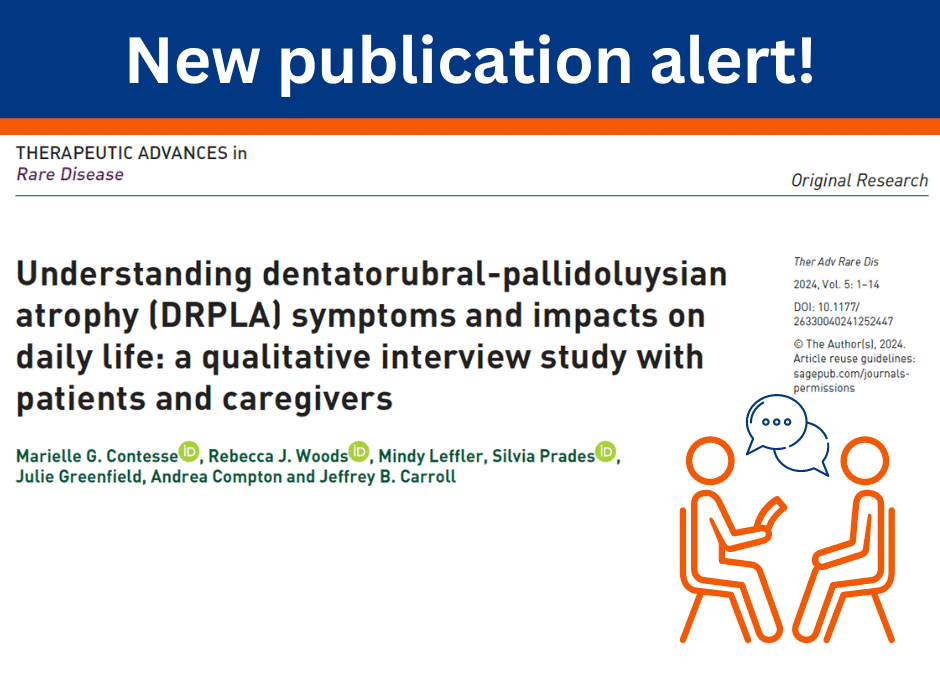CureDRPLA has been funding research that aims to better understand DRPLA symptoms and how this condition develops over time, such as the DRPLA Natural History and Biomarkers Study. While such research projects are essential for advancing research towards clinical trials, the value of collecting the lived experiences of people with DRPLA should not be underestimated.
To address this knowledge gap, CureDRPLA asked researchers to conduct interviews with people with DRPLA and their caregivers to better understand symptoms, impact on daily life, and explore treatment goals and clinical trial preferences. Researchers interviewed patients and caregivers, reporting the experiences of 18 people with DRPLA.
In these interviews, they quantified which symptoms are more common and their impact. For example, a caregiver of an adult patient with DRPLA described personality changes:
“He was very patient. Well he’s no longer patient, he gets riled up extremely quickly, he gets really angry with the children. It’s very, very difficult, because it’s like somebody changed my husband for a completely different one.” (ID 3.02, Caregiver)
A caregiver of a juvenile-onset patient provided this description about worsening ability of patients to use their hands:
“When he was young, 5, 6 years old, he was doing better than he is now. He was able to write his name, he was able to hold a pencil, write a sentence, you know, do those kinds of things. Since that time, within the last year or so, he has definitely deteriorated with his fine motor skills. He is no longer able to write very well at all. He gets frustrated pretty quickly with it, because it takes so much effort just to write, you know, his name. And so, to write a sentence or anything, he just, he can’t do it. And his writing isn’t very legible anymore.” (ID 5.01, Caregiver)
An important part when designing clinical trials is to incorporate the views of people with DRPLA and their caregivers. They are the most knowledgeable about the condition and they have priorities as to what they would prefer the treatment to improve the most. These interviews also captured what patients and caregivers would most like to see improved with treatment. For example, a person with DRPLA described that they would like their ataxia to improve:
“I’m going to say if it can pull the ataxia, for me, that’d be the major thing. That keeps me from being normal. I feel that really keeps me from being normal.” (ID 6.01, Patient)
Independence was reported by caregivers of children and young adults with DRPLA:
“Independent living, like being able to care for yourself . . . it’s huge, because, you know, if you can’t care for yourself, then you are a burden on somebody else, which takes, you know, quality of life for two people.” (ID 1.02, Caregiver)
All adults interviewed and 93% of caregivers reported that the patient would participate in a clinical trial for DRPLA treatment if the opportunity was given. However, traveling to a distant clinical site could be a barrier to clinical trial participation.
“Traveling with [ID 03.01] is difficult, and also it’s difficult for him to travel. It makes his epilepsy worse, and it tires him out . . . so, not having to travel too far would be a definite bonus. But, I mean, otherwise we would do anything.” (ID 3.01, Caregiver)
The findings from these interviews can be incorporated into the design of future clinical trials, ensuring they address the most impactful and prioritized symptoms for patients and caregivers. You can read the full article here, with all the findings from these interviews.
We extend our gratitude to all the patients and their caregivers who participated in these interviews. Your valuable contributions have provided crucial insights that will shape the future of DRPLA research and treatment. Thank you for sharing your experiences and perspectives with us.

